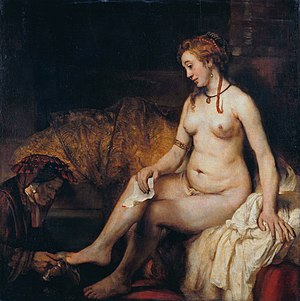Bathsheba at Her Bath (Rembrandt)
| Bathsheba at Her Bath | |
|---|---|
 |
|
| Artist | Rembrandt |
| Year | 1654 |
| Medium | Oil on canvas |
| Dimensions | 142 cm × 142 cm (56 in × 56 in) |
| Location | The Louvre, Paris |
|
|
Bathsheba at Her Bath (or Bathsheba with King David's Letter) is an oil painting by the Dutch artist Rembrandt (1606–1669) finished in 1654.
A depiction that is both sensual and empathetic, it shows a moment from the Old Testament story in which King David sees Bathsheba bathing and, entranced, seduces and impregnates her. In order to marry Bathsheba and conceal his sin, David sends her husband into battle and orders his generals to abandon him, leaving him to certain death.
While the scene of David spying on Bathsheba had been painted by earlier artists, Rembrandt's depiction differs in its tight pictorial focus and erotic vitality, achieved through broad, thick brushstrokes and vibrant coloration.
The painting hangs in The Louvre; it is one of 583 works donated by Dr. Louis La Caze in 1869. For Kenneth Clark, the canvas is "Rembrandt's greatest painting of the nude". Its insight into Bathsheba's moral dilemma has been described as "one of the great achievements of western painting."
The Second Book of Samuel (11:2-4) gives the account of King David who saw a woman bathing from his palace roof. When he asked after her, he was told that she was Bathsheba, daughter of Eliam and wife of Uriah the Hittite. David had his messengers retrieve her, and after they slept together she became pregnant with his child. David was able to marry Bathsheba by sending Uriah into battle where he was killed.
Prior to Bathsheba at Her Bath, the standard treatment had been to show Bathsheba bathing out of doors—thus accounting for her visibility to David—and accompanied by maidservants. A tower could usually be seen in the distance, and perhaps a small figure of David, sometimes accompanied by his two courtiers. Such was the design Rembrandt's earlier The Toilet of Bathsheba, dated 1643. By eliminating David, his messengers and most of the traditional narrative elements from the picture—the only anecdotal references included are the letter from David (not actually mentioned in Samuel) and the presence of an attendant drying her foot—Rembrandt's presentation of Bathsheba is both intimate and monumental. As a result, the moralistic theme of previous treatments of the subject is replaced by a direct eroticism in which the viewer supplants David as voyeur.
...
Wikipedia
